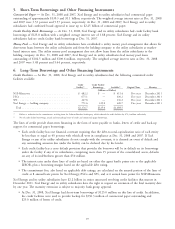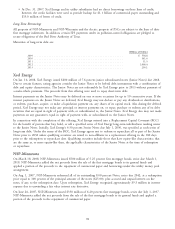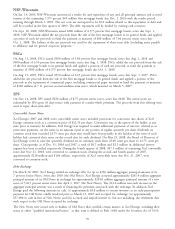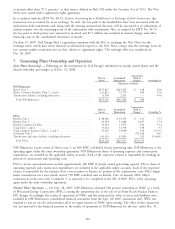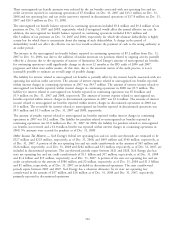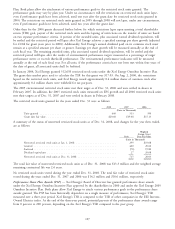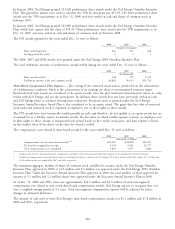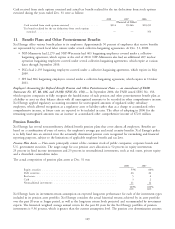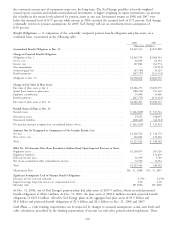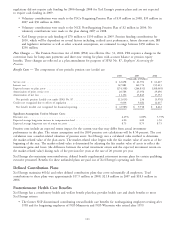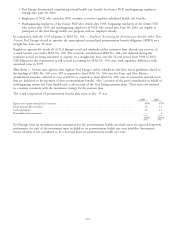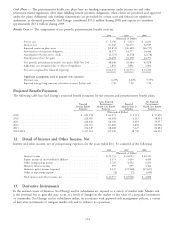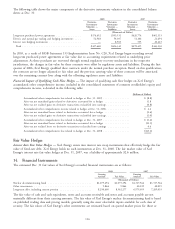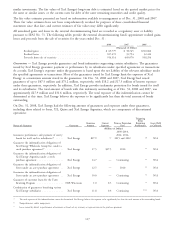Xcel Energy 2008 Annual Report Download - page 117
Download and view the complete annual report
Please find page 117 of the 2008 Xcel Energy annual report below. You can navigate through the pages in the report by either clicking on the pages listed below, or by using the keyword search tool below to find specific information within the annual report.
Plan. Both plans allow the attachment of various performance goals to the restricted stock units granted. The
performance goals may vary by plan year. Under no circumstances will the restrictions on restricted stock units lapse,
even if performance goals have been achieved, until one year after the grant date for restricted stock units granted in
2004. The restrictions on restricted stock units granted in 2005 through 2008 will not lapse, under any circumstances,
even if performance goals have been achieved, until two years after the grant date.
Other than for the 2004 grants discussed further below, for which restrictions lapse upon meeting a total shareholder
return (TSR) goal, payout of the restricted stock units and the lapsing of restrictions on the transfer of units are based
on two separate performance criteria. A portion of the awarded units, plus associated earned dividend equivalents, will
be settled and the restricted period will lapse after Xcel Energy achieves a specified earnings per share growth (adjusted
for COLI for grant years prior to 2008). Additionally, Xcel Energy’s annual dividend paid on its common stock must
remain at a specified amount per share or greater. Earnings per share growth will be measured annually at the end of
each fiscal year. The remaining awarded units, plus associated earned dividend equivalents, will be settled and the
restricted period will lapse after the results of environmental performance targets measured as a percentage of target
performance meets or exceeds threshold performance. The environmental performance indicators will be measured
annually at the end of each fiscal year. For all units, if the performance criteria have not been met within four years of
the date of grant, all associated units shall be forfeited.
In January 2004, Xcel Energy granted 512,638 restricted stock units under the Xcel Energy Omnibus Incentive Plan.
The grant-date market price used to calculate the TSR for this grant was $17.03. On Aug. 2, 2006, the restrictions
lapsed on the restricted stock units, and Xcel Energy issued approximately 0.4 million shares of common stock after
approximately 0.2 million shares were withheld for tax purposes.
The 2005 environmental restricted stock units met their target as of Dec. 31, 2006 and were settled in shares in
February 2007. In addition, the 2005 restricted stock units measured on EPS growth and all 2006 restricted stock units
met their targets as of Dec. 31, 2007 and were settled in shares in February 2008.
The restricted stock units granted for the years ended Dec. 31 were as follows:
2008 2007 2006
(Units in Thousands)
Units granted ................................... 460 313 390
Grant date fair value ............................... $20.60 $19.08 $15.13
A summary of the status of nonvested restricted stock units as of Dec. 31, 2008, and changes for the year then ended,
are as follows:
Weighted
Average Grant
Units Date Fair Value
(Units in Thousands)
Nonvested restricted stock units at Jan. 1, 2008 ........................ 299 $19.08
Granted ................................................. 460 20.60
Forfeited ................................................. (71) 19.80
Dividend equivalents ......................................... 27 20.08
Nonvested restricted stock units at Dec. 31, 2008 ....................... 715 20.03
The total fair value of nonvested restricted stock units as of Dec. 31, 2008 was $13.3 million and the weighted average
remaining contractual life was 2.6 years.
No restricted stock units vested during the year ended Dec. 31, 2008. The total fair value of restricted stock units
vested during the years ended Dec. 31, 2007 and 2006 was $14.2 million and $10.6 million, respectively.
Performance Share Plan Awards (PSP) — Xcel Energy’s Board of Directors has granted performance share awards
under the Xcel Energy Omnibus Incentive Plan approved by the shareholders in 2000 and under the Xcel Energy 2005
Omnibus Incentive Plan. Both plans allow Xcel Energy to attach various performance goals to the performance share
awards granted. The PSP has been historically dependent on a single measure of performance, Xcel Energy’s TSR
measured over a three-year period. Xcel Energy’s TSR is compared to the TSR of other companies in the EEI Investor-
Owned Electrics index. At the end of the three-year period, potential payouts of the performance share awards range
from 0 percent to 200 percent, depending on the Xcel Energy’s TSR compared to the peer group.
107


